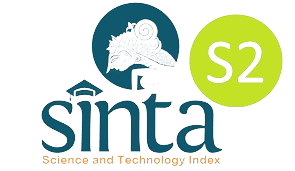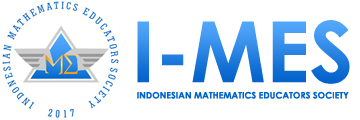Kertas Berpetak pada Pembelajaran Perbandingan Senilai
DOI:
https://doi.org/10.29408/jel.v2i2.181Keywords:
design research, comparison worth, paper terraced, PMRIAbstract
This study aims to generate trajectories of students in learning by using a comparison worth growing terraced paper of form informal toward formal shape. The method used in this research is the research design consisted of three stages, namely the preliminary, design experiments and retrospective analysis. In this study, a series of learning is designed and developed based on the notion of the learning process and approach PMRI. This research was conducted in SMP PGRI 1 Palembang by involving students in grade VII.2 totaling 30 students. This research produces Learning trajectory (LT), which includes three activities namely 1, activity starts from drawing two wake up the same but different size, measure each side at the wake and determine the corresponding sides to determine the ratio. Activity 2, the activity determines the relations between the two ratios to determine whether the two ratios is a comparison worth or not. Activity 3, resolve issues relating to the comparative worth of daily life-today. Results of the experiments showed that a series of learning activities that have been done to help improve students' understanding of learning valued comparison.
References
Akker, et al. (2006). Education Design Research. London : Routledge Taylor and Francis Group.
Ben-Chaim, Keret, & Ilany, (2012). Ratio Proportional.Sence Publishers Rotterdam Boston/Taipei.
Gravemeijer, K. (1994). Developing Realistic mathematics Education. Utrecht : Freudential Institute.
Gravemeijer, K. Local Insructional Theories as means of Support for Teacher in Reform Mathematics Education. Mathematics Thinking and Learning, 6(2), 105-128, Lawrence Erlbaum Association, Inc.
Gravemeijer, K., & Cobb, P. (2006). Design Research from a Learning Design Perspective. In J. V. D Akker, K.P.E. Gravemeijer, S. McKenney, N. Nieven (Eds), Educational Design Research (pp. 17-51). London: Routledge.
Gravemeijer, K., & Van Eerde, D. (2009). Research as a Means for Building a Knowladge Base for Teaching In Mathematics Education. The Elementary School Journal. 109(5). 510-524.
Ilma, R. (2012). Pendisainan Hypohtetical Learning Trajectory (HLT) Cerita Malinkundang pada Pembelajaran Matematika. Dalam Prosiding Seminar Nasional Matematika dan Pendidikan Matematika, Yogyakarta, tanggal 10 November 2012. Universitas Negeri Yogyakarta.
Lamon, S. (1994). Ratio and Proportion: Cognitive Foundetions in Unitizing and norming. In H. Guershon & J. Confrey ( Eds.), The development of multiplicative rasoning in the learning mathematics (pp.89-120). Albany.
Lesh, R.,Post, T. & Behr, M. (1988). Proportional reasoning. In A.Kelly & R.Lesh (Eds.), Number concepts and operations in the middle grades (pp. 93-118). Hillsdale, NJ:Lawrence Erlbaum, and reston, VA:National Council of Teacher Mathematics. NY: State Unuversity Of New York Press.
National Council of Teachers of Mathematics (NCTM). (2013). Teaching Ratio and Proportion in the Middle Grades. Ratio and Proportion Research Brief.
Pitalis, Marios et al. Students Ability In Solving Proportional Problems. Tematic Group 3. European Research In Mathematics Education III.
Rahayuningrum. (2009). Upaya meningkatkan kemampuan menyelesaikan soal matematika dengan model pembelajaran kooperatif tipe STAD pada materi perbandingan siswa kelas VII SMP N 1 Mogiri bantul Yogyakarta. Dalam Prosiding Seminar Nasional Matematika. Yogyakarta, Tanggal 6 Desember 2012, 92. Universitas Negeri Yogyakarta.
Tourniaire,F & Steven P. (1985). Proportional Reasoning: A Review of the Literature Educational Studies in Mathematics,16,181-204. Calipornia :Group in Science and mathematics Education, Lawrence Hall of Science, University of California
Van De Walle, J.A. (2008). Matematika Sekolah Dasar Dan Menengah: Pengembangan Pengajaran. Jilid Kedua. Jakarta: Erlangga.
Wijaya, Ariyadi. (2012). Pendidikan Matematika Realistik : Suatu Alternatif Pendekatan Pembelajaran Matematika. Yogyakarta : Graha Ilmu
Wight, & Dale. (2006). Proportional Reasoning. Australia : The University Of Queenland.
Zulkardi. (2006). RME suatu inovasi dalam pendidikan matematika d Indonesia. Makalah disajikan pada Konferensi Matematika Nasional XIII. Bandung ITB.
Zulkardi. (2009). The “P†in PMRI: Progress and Problem. In Proceeding of IICMA 2009 Mathematics Education, pp. 773-780. Yogyakarta: IndoMs.
Zulkardi & Ilma, R. (2010). Pengembangan Blog Support untuk Membantu Siswa dan Guru Matematika Indonesia Belajar Pendidikan Matematika Realistik Indonesia (PMRI). Tersedia online : http://eprints.unsri.ac.id/540/1/Prof.Dr.Zulkardi_Dr.Ratuilma_di_JIPP-Balitbang.pdf.
Downloads
Published
How to Cite
Issue
Section
License
Authors who publish with the Jurnal Elemen agree to the following terms:
- Authors retain copyright and grant the journal right of first publication with the work simultaneously licensed under Creative Commons Attribution-ShareAlike 4.0 International License (CC BY-SA 4.0).
- Authors are able to enter into separate, additional contractual arrangements for the distribution of the journal's published version of the work (e.g., post it to an institutional repository or publish it in a book), with an acknowledgment of its initial publication in this journal.
- Authors are permitted and encouraged to post their work online (e.g., in institutional repositories or on their website) prior to and during the submission process, as it can lead to productive exchanges, as well as earlier and greater citation of published work.
Jurnal Elemen is licensed under a Creative Commons Attribution-ShareAlike 4.0 International License





